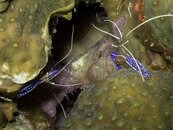u4ia
Contributor
yes reefdiva- I have the BSDME book which is very helpful and I have Humann and Deloach's reef fish book (not the reef behavior one though), so I am rereading both of those too. I like the early am and late afternoon diving too-- I cant take that midday heat too well!! I couldnt believe the first time I witnessed the wrasse commute, wow it was an endless stream of fish going and going and going... I thought maybe it was some giant fish circle, it seemed like an endless loop. cant wait to go back.




